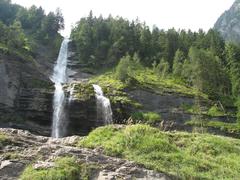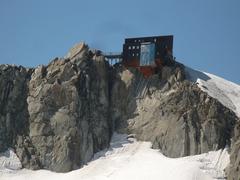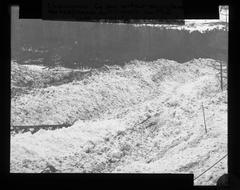
Refuge de Leschaux Visiting Hours, Tickets, and Comprehensive Guide
Date: 04/07/2025
Introduction
Perched at 2,431 meters in the heart of the Mont Blanc massif near Chamonix-Mont-Blanc, Refuge de Leschaux is more than a remote mountain shelter—it is a symbol of alpine heritage, mountaineering history, and environmental stewardship. Overlooking the Glacier de Leschaux and facing legendary peaks such as the Grandes Jorasses, the refuge is both a strategic base for climbers and a living monument to centuries of exploration in the Alps. This guide details everything you need to know for a successful visit, including history, access, hours, ticketing, facilities, safety, and nearby attractions.
For the most current and official information, consult the Refuge de Leschaux official website and the Chamonix Tourism Office. For further context, see SummitPost and 1786.travel.
Table of Contents
- Historical Background and Cultural Significance
- Visiting Hours and Ticketing
- Access and Approach Routes
- Climate, Flora, and Fauna
- Environmental Challenges and Conservation
- Facilities and Accommodation
- Visitor Experience
- Safety Considerations
- Nearby Attractions
- FAQ
- Visual Resources
- References
Historical Background and Cultural Significance
Early Exploration and the Birth of Alpine Refuges
Before the mid-18th century, the Mont Blanc massif was known as the “cursed mountains,” shrouded in mystery and avoided by locals and scientists (SummitPost). The 1741 ascent by William Windham and Richard Pococke to Montenvers and the Mer de Glace, and Pierre Martel’s subsequent mapping, drew scientific and mountaineering attention to the region.
The Dawn of Modern Mountaineering
The first ascent of Mont Blanc in 1786 by Jacques Balmat and Michel-Gabriel Paccard was a watershed moment (1786.travel). This feat inaugurated the tradition of alpine guiding and established Chamonix as the cradle of mountaineering, eventually leading to the construction of refuges to support climbers and explorers.
The Strategic Role of Refuge de Leschaux
Established in the early 20th century, Refuge de Leschaux provided much-needed shelter for those attempting major ascents on nearby peaks like the Grandes Jorasses. Over the decades, the refuge has been modernized while retaining its essential role as a hub for climbers and a center for mountain culture and environmental awareness.
Visiting Hours and Ticketing
- Opening Season: The refuge is open from mid-June to mid-September, aligning with the main alpine climbing season. Outside this period, only the winter shelter is available for emergencies (Refuge Leschaux Official).
- Hours: The staffed refuge operates daily, typically from early morning until evening.
- Reservations: Overnight stays require advance booking via the official reservation portal due to limited capacity.
- Ticketing & Prices: As of 2024–2025, the standard rate for the unguarded period is €10 per person, with discounts for FFCAM members, youth, and groups (FFCAM Tarifs). Confirm accepted payment methods before arrival.
Access and Approach Routes
Primary Summer Route
- Starting Point: Montenvers cog railway station (1,913 m) in Chamonix.
- Route: Descend ladders to the Mer de Glace, traverse the glacier, then ascend the Glacier de Leschaux via marked paths and fixed ropes.
- Duration: 3.5–4.5 hours.
- Required Equipment: Crampons, harness, helmet, rope, navigation tools.
- Guide Recommendation: Due to glacier hazards, hiring a certified guide is strongly advised for those without glacier travel experience (refugeleschaux.ffcam.fr).
Winter and Alternative Routes
- Winter: Ski touring approaches from Montenvers or Aiguille du Midi, with avalanche safety gear required.
- Alternative: Traverse from Refuge du Couvercle or ski from Aiguille du Midi via the Vallée Blanche for experienced mountaineers.
Climate, Flora, and Fauna
- Weather: High-alpine conditions prevail—cold, variable, and often severe. Sudden storms and snow are possible even in summer.
- Flora/Fauna: The immediate area is mostly rock, ice, and snow, with hardy alpine plants and occasional wildlife sightings (chamois, ibex, alpine birds) in lower valleys.
Environmental Challenges and Conservation
- Glacial Retreat: Ongoing climate change has altered access routes and increased hazards.
- Sustainable Management: Operated by the Club Alpin Français, the refuge employs strict reservation systems and sustainable practices for water, waste, and energy. Visitors are encouraged to respect Leave No Trace principles (Refuges.info).
Facilities and Accommodation
Shelter and Common Areas
- Main Building: Communal dining area, sunny terrace with panoramic views, and a sociable atmosphere (SeeChamonix.com).
- Sanitation: Basic; water from snowmelt, no running water, limited washing facilities.
- Electricity: Reserved for essential operations, no device charging available.
Food and Beverage
- Meals: Half-board (dinner, overnight, breakfast), bed-and-breakfast, or bed-only. Simple, hearty, homemade dishes are served.
- Drinks: Limited selection due to resupply logistics.
Sleeping Arrangements
- Capacity: 22 in summer (dormitory bunks, bring sleeping bag liner), 12 in winter room (blankets provided, no heat or gas).
- Bivouacking: Permitted sunset to sunrise, following strict environmental regulations.
Visitor Experience
- Atmosphere: Friendly, communal, and international. The small capacity fosters genuine camaraderie.
- Guardian: The refuge is managed by knowledgeable staff (currently Chloé Laget).
- Special Events: Occasional guided workshops and mountaineering events—check official channels for details.
- Pets: Not permitted inside for hygiene reasons (Combloux.com).
Safety Considerations
- Glacier Hazards: Heavy crevassing, seracs, rockfall—rope teams and proper rescue equipment are mandatory.
- Weather: Rapid changes, avalanche risk in winter—consult forecasts and carry appropriate safety gear.
- Physical Demands: Not suitable for beginners or children; technical approach includes ladders and glacier travel.
- Communication: No reliable mobile signal—consider satellite devices and always inform someone of your itinerary.
Nearby Attractions
- Mer de Glace: Accessible from Montenvers station.
- Grandes Jorasses: Iconic climbing objective.
- Chamonix: Town with museums, historical sites, and alpine culture.
- Aiguille du Midi: Cable car with panoramic views.
Frequently Asked Questions (FAQ)
Q: When is the best time to visit?
A: Mid-June to mid-September for the staffed season; winter room available for emergencies year-round.
Q: How do I book my stay?
A: Reservations are mandatory and can be made via the official FFCAM portal.
Q: Is the refuge suitable for non-climbers?
A: The approach is technical and requires alpine experience or a guide.
Q: Are there guided tours?
A: Yes, especially in summer—contact the refuge or local guides for options.
Q: Can I charge my phone?
A: No, electricity is limited and device charging is not available.
Q: Is the refuge accessible to people with disabilities?
A: No, due to the technical and glaciated terrain.
Visual Resources
For maps, photos, and virtual tours, refer to the FFCAM website and related hiking portals.
References and Further Reading
- Mont Blanc: The 1rst Ascent and the First Mountaineering Controversy (SummitPost)
- August 8, 1786: The Story of the First Ascent of Mont Blanc (1786.travel)
- Refuge Leschaux FFCAM Official Website
- Refuge de Leschaux Official Website
- Refuge de Leschaux Access and Booking (refuges.info)
- Facilities and Accommodation (SeeChamonix.com)
- Tariffs (FFCAM)
- Visitor Information (Combloux.com)
- Chamonix Tourism Office
- Chamonix-Mont-Blanc Hiking Guide
Final Tips
- Reserve early—spaces fill quickly in the summer.
- Prepare for basic amenities—bring your own sleeping bag liner, hygiene supplies, and water purification.
- Plan for no mobile connectivity—carry offline maps and inform others of your route.
- Respect the environment—follow all refuge rules and leave no trace.
For the latest updates, download the Audiala app and follow our social media for alpine safety tips, weather alerts, and trail guides.









